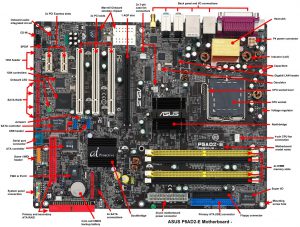The motherboard serves to connect all of the parts of a computer together. The CPU, memory, hard drives, and other ports and expansion cards all connect to the motherboard directly or via cables.

The motherboard is the piece of computer hardware that can be thought of as the “backbone” of the PC, or more appropriately as the “mother” that holds all the pieces together.
Phones, tablets and other small devices have motherboards too but they’re often called logic boards instead.
Their components are usually soldered directly onto the board to save space, which means there aren’t expansion slots for upgrades like you see in desktop computers.
The IBM Personal Computer that was released in 1981, is considered to be the very first computer motherboard (it was called a “planar” at the time).
Popular motherboard manufacturers include ASUS, AOpen, Intel, ABIT, MSI, Gigabyte, and Biostar.
Note: A computer’s motherboard is also known as the mainboard, mobo (abbreviation), MB (abbreviation), system board, baseboard, and even logic board. Expansion boards used in some older systems are called daughterboards.
Motherboard Components:-
Everything behind the computer case is connected in some way to the motherboard so that all the pieces can communicate with each other.
This includes video cards, sound cards, hard drives, optical drives, the CPU, RAM sticks, USB ports, a power supply, etc.
On the motherboard are also expansion slots, jumpers, capacitors, device power and data connections, fans, heat sinks, and screw holes.
Important Motherboard Facts:-
Desktop motherboards, cases and power supplies all come in different sizes called form factors. All three must be compatible to work properly together.
Motherboards vary greatly with respect to the types of components they support. For example, each motherboard supports a single type of CPU and a short list of memory types. Additionally, some video cards, hard drives, and other peripherals may not be compatible. The motherboard manufacturer should provide clear guidance on the compatibility of components.
In laptops and tablets, and increasingly even in desktops, the motherboard often incorporates the functions of the video card and sound card. This helps keep these types of computers small in size. However, it also prevents those built-in components from being upgraded.
Poor cooling mechanisms in place for the motherboard can damage the hardware attached to it. This is why high performance devices like the CPU and high-end video cards are usually cooled with heat sinks, and integrated sensors are often used to detect the temperature and communicate with the BIOS or operating system to regular the fan speed.
Devices connected to a motherboard often need device drivers manually installed in order to make them work with the operating system. See How to Update Drivers in Windows if you need help.
Physical Description of a Motherboard:-
In a desktop, the motherboard is mounted inside the case, opposite the most easily accessible side.
It is securely attached via small screws through pre-drilled holes.
The front of the motherboard contains ports that all of the internal components connect to. A single socket/slot houses the CPU. Multiple slots allow for one or more memory modules to be attached. Other ports reside on the motherboard, and these allow the hard drive and optical drive (and floppy drive if present) to connect via data cables.
Small wires from the front of the computer case connect to the motherboard to allow the power, reset, and LED lights to function. Power from the power supply is delivered to the motherboard by use of a specially designed port.
Also on the front of the motherboard are a number of peripheral card slots. These slots are where most video cards, sound cards, and other expansion cards are connected to the motherboard.
On the left side of the motherboard (the side that faces the back end of the desktop case) are a number of ports. These ports allow most of the computer’s external peripherals to connect such as the monitor, keyboard, mouse, speakers, network cable and more.
All modern motherboards also include USB ports, and increasingly other ports like HDMI and FireWire, that allow compatible devices to connect to your computer when you need them – devices like digital cameras, printers, etc.
The desktop motherboard and case are designed so that when peripheral cards are used, the sides of the cards fit just outside the back end, making their ports available for use.